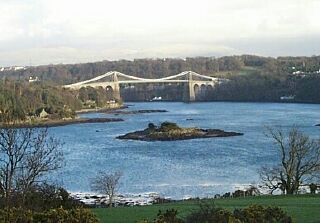
| |More About Wales|OF Home Page| Prospectus / Prospectws| What do we think? / Beth am OF? |
Operation Friendship - Cymru/Wales
The Geography and Landscape of Wales

Wales, on the western shores of Britain, has a maximum length of 140 miles and is 100 miles across at its widest. It is a mountainous country. Around one quarter of the land is above 305m (1,000ft) and in the north the peak of Snowdon rises to 1,085m (3,560ft), the highest point in England and Wales. Wales' 732-mile coastline is a varied one, consisting of bays, beaches, peninsulas and cliffs. The largest bay - Cardigan Bay - gives the west-facing Welsh coastline its distinctive 'horseshoe' shape. The largest island, connected to the mainland by road and rail bridges, is Anglesey in the north.
Wales' landscape is essentially rural. In terms of land use, 81% is used for agriculture, 12% is covered in woodland, and only 8% is categorised as urban. Most of the country's population of 3.5 million is concentrated in the south-eastern corner around the capital city of Cardiff. The city, population 270,000, grew up in the 19th century as a coal-exporting port. The Industrial Revolution of the 18th and 19th centuries had its major impact in South Wales, where the iron and steel factories and coal mines were concentrated. Swansea, also in the south, is Wales's second city with a population of 177,000. Newport, to the east of Cardiff near the Welsh border, has a population of 130,000. Like Cardiff, Swansea and Newport owe their growth to the industries of South Wales and their location as ports on the Bristol Channel.
The Welsh Language is a Celtic language, related to Breton, Irish and Scots Gaelic. Its roots are lost in time, but it is regarded by some scholars to be Europe's oldest living language. Welsh and English enjoy equal validity in Wales and approximately one quarter of the population speaks Welsh fluently. In many parts of Wales at least seven out of ten people are Welsh speaking, and use Welsh as their first language at home and at work. Visitors will hear Welsh spoken as an every day language.
Children in Wales may receive Infant, Primary and Secondary education through the medium of Welsh, and, in some instances, students may receive a college education in Welsh. Spoken Welsh varies in dialect in different parts of the country. Written Welsh is standard. Since 1982, there has been a Welsh language television channel, S4C.